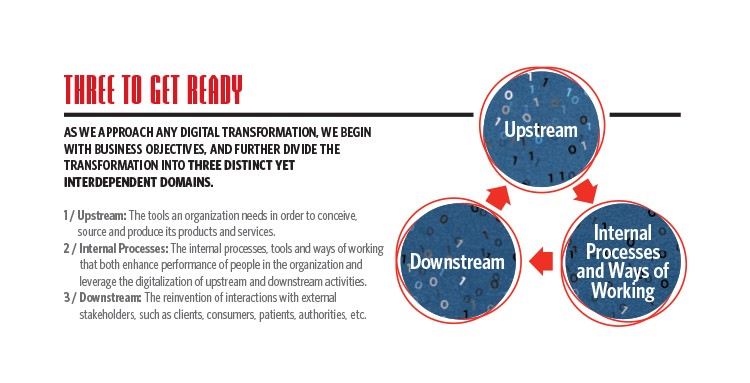Transforming the Approach to Digital Transformation
Home Depot had a problem. The company was good at selling its products in stores, but not adept at selling them online. As more customers demanded digital shopping options, The Home Depot was falling behind its competitors in digital commerce. The solution: Starting in 2017, The Home Depot spent $11 billion on an effort to use new technology to boost online purchases, better manage inventory, and robustly track customer data. It hired 1,000 new information technology employees in the process. The payoff: a $17 billion increase in annual revenue, which hit $110 billion in 2019. The effort also left The Home Depot well positioned for customers who wanted to buy online and pick up curbside when the COVID-19 pandemic forced stores to close.
This kind of successful digital transformation is much sought after in global business today. And it is why as many as 80% of all global companies have engaged in a digital transformation of some kind during the past five years.
COVID-19 has only accelerated this trend. Twilio, a cloud communications platform company based in San Francisco, recently surveyed 2,500 executives worldwide and found 97% of them said their company’s digital transformation efforts had been sped up by the pandemic. The survey also found that 79% of companies have increased their budgets for digital transformation in response to the pandemic.
Companies that have successfully completed digital transformations have boosted market share and revenue; created more engaged, happier customers; improved business processes; lowered costs and cut product development time. Results like these, as well as the promise of opening brand-new markets with tech tools, have lured many global companies into digital transformation projects. The pandemic has accelerated many of these to breakneck speed as companies have rapidly created virtual workplaces and sales channels.
CIOs and IT managers may be glad to hear that more resources are coming their way as this change process speeds up. But companies should also be wary of spending money in the wrong ways and on the wrong things. Many executive teams may lack a comprehensive and shared understanding of what digital transformation can and cannot make possible for their organization. This shared understanding is critical for the leadership to drive the changes and engage employees to a voice at all levels, and make sure that digital change is not focused only on “tech people.”

Digital Transformation Is About More Than Just the Technology
Moving data to the cloud, building a new app for customer interaction and converting business processes to run at 5G speeds are all technical elements of a digital transformation. But none of them, by themselves, create real transformation. For instance, Visa recently digitized the way it processes cross-border remittances, which have been increasing because of the pandemic. That is a big, important change for Visa. But it is not, by itself, a digital transformation.
True digital transformation is a broad effort to change the organizational mindset and to use new technologies to push that change in mindset forward. Share on X Like all organizational transformations, it begins with questions such as, “What do we want to accomplish?” and, “Who do we want to be in the marketplace?” Once these questions are answered, companies can ask the technological questions, such as, “How do we leverage data and technology to get there faster and better?” and, “How will these technologies increase our teams’ ability to fulfill their missions?” It does not matter whether the tech of the day is 5G or something else. What matters is the process of redefining a company and its strategic outcomes. The adoption of tech should always be in service of the new future.
Consider the case of Pitney Bowes. The 100-year-old company was once known mostly for its postage meters. But in 2012 it embarked on a digital transformation under the leadership of CEO Marc Lautenbach. His goal was to change the company’s view of itself and its future. From there, Pitney Bowes was able to identify new ways to create value. The transformation included the creation of an entirely new business unit focused on digital tools and services, including mobile apps. That unit now delivers more than $1 billion of annual e-commerce business.
“Instead of starting with, “what do we have to do in a digital transformation?,” the mindset that provides real acceleration is, “Let’s commit to X, Y and Z. What do we need to make that true?”
Online marketplace eBay, for one, uses Pitney Bowes software to automatically determine where any given package can be shipped internationally and how much the duty on that item will cost. Another piece of Pitney Bowes software pinpoints the locations of 1.2 billion users of social media for the likes of Zillow, Twitter and other social platforms.
The technology powering these changes matters to Pitney Bowes. But the company’s change in thinking about what it wanted to be and where it wanted to go came first. Starting in the right place, as Pitney Bowes did by redefining itself first and adopting new technology second, is key to accelerating digital transformation. So, too, is the involvement of leadership. Because digital transformation is a fundamental change in how an organization does business, top leaders have to commit to the transformation; make it a priority; and continually and clearly articulate where the digital transformation will lead, what its specific objectives are, why the change is important, and what the milestones will be.
These leaders should clearly state that it’s okay to forgo “business as usual” processes in search of something new. Anheuser-Busch, for instance, developed its own business-to-business software platform to communicate with retailers and others who carry its products. The system includes AI that recognizes when a retailer may be getting low on inventory and alerts the retailer to place an order. There is a bigger transformation story here than simple automation: Because salespeople no longer have to worry about making phone calls to track reorders, they are freed to focus on selling new products.
People Matter as Much as the Technology
Leadership is critical in transformation, but an organization has to engage all of its employees as active participants in a transformation rather than just communicating the changes to them. In other words, we believe in employee-led transformation.
Microsoft took this approach in the digital transformation it began in 2014. That year the company moved to a subscription model for its software sales and began offering cloud-based computing solutions for corporate clients. To drive the change, Microsoft tasked its Core Services Engineering and Operations team to survey employees across divisions about how their jobs would have to change and about the support they would need to make change happen. Using that survey, Microsoft created a single document called “CSEO Product Vision.” It served as a blueprint for executing all the elements of the company’s digital transformation—in all the different parts of the company—over the next few years.
Still, employee-led digital transformations are rare. Most digital transformations are led by technical experts—sometimes from outside the organization. Because these experts may not fully appreciate how their tools will affect a company’s nontechnical workforce, they can sometimes implement new tech tools that workers do not embrace. That can slow transformations down and waste a tremendous amount of resources.
For example, we recently worked with a company to accelerate a digital transformation that had stalled. The company, which sells various food products to consumers, ran into a big problem. The new data analytics software tools it had installed were producing reams and reams of data that employees were expected to analyze to identify sales trends. It was overwhelming. The organization had gotten ahead of itself. The better approach is to start by identifying the desired end state and then finding the right tools. In other words, instead of starting with, “what do we have to do in a digital transformation?,” the mindset that provides real acceleration is, “let’s commit to X, Y, and Z. What do we need to make that true?”
Re-skilling is often needed. Kaiser Permanente, for instance, embarked on a digital transformation last decade that vastly expanded its telehealth offerings. As more than 100 million of its patient encounters went virtual, it re-skilled its workers to become experts in the new digital tools their jobs required.
One of our clients has also turned to re-skilling to execute on the objectives of a digital transformation. The client, a major European utility, specializes in wastewater treatment. It recently expanded into soil and air cleanup, and its newer efforts involve the use of high-tech analysis tools that many of the utility’s wastewater experts are unfamiliar with. That has meant sending two different groups—wastewater experts as well as soil and air experts—to talk with the town councils that are the utility’s end clients. But now, the utility is cross-training its workers to understand the new and the old aspects of its business so that everyone, in a sense, can speak the same language.
Translating Technology Across the Enterprise
Too often, companies are trying to drive digital change simply by boosting the budgets of an IT or IS department, or an individual business unit, or perhaps even some type of in-house “innovation lab.” This can lead to a disconnect between what executives believe they can accomplish in a digital transformation and the scope of the work employees are actually going to be able to handle.
Companies should also be wary of investing in a vast expansion of the tech team. Bringing in dozens or hundreds or even thousands of new workers who specialize in operating and overseeing new technology may not be necessary if less-expensive outsourcing options are available.
Big digital and data departments often focus too much on technology and not enough on the broader objectives of the business. After all, that’s what they’ve been assembled to do — run the numbers, collect the information, fine-tune the technological tools. But in a transformation, the tech teams need to be part of the overall organizational change in mindset. This means everyone needs to think beyond their traditional roles.
Similarly, those who create value in the organization should be involved with any expansion of digital business units and with the implementation of any new technologies meant to help the business. To ensure that technology is being adopted in service of the company’s change objectives, the value creators and the tech teams, like our European utility client, need to find a way to speak the same language to each other. When they do, digital transformation can truly create unprecedented value for all.
This article appeared in the Winter 2021 issue of Insigniam Quarterly. To begin receiving IQ, go here.



